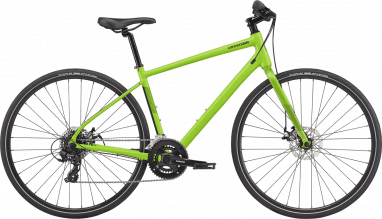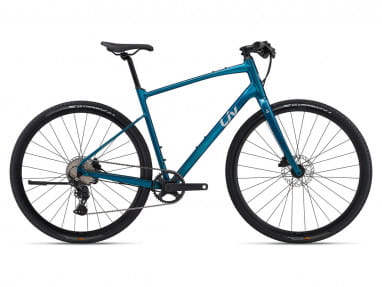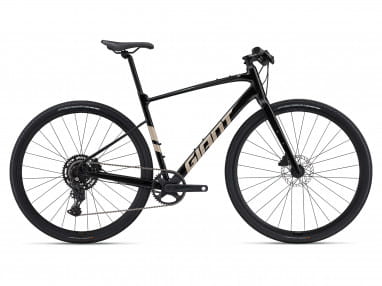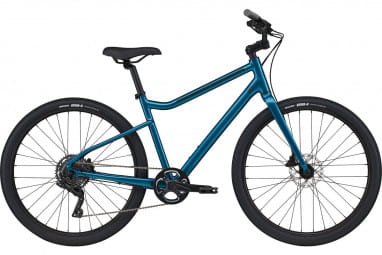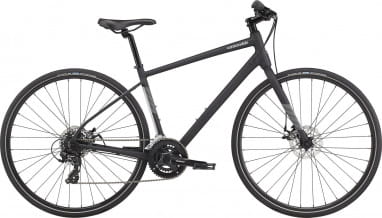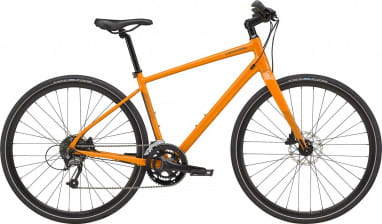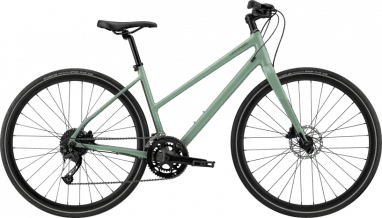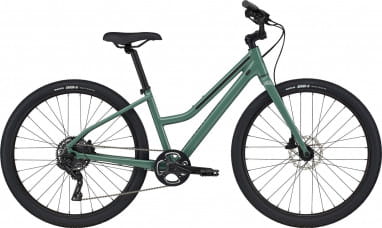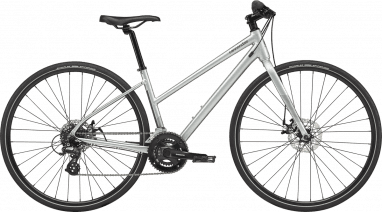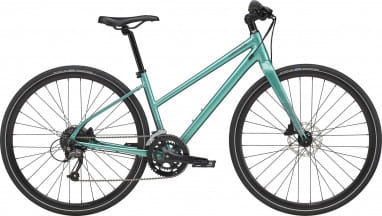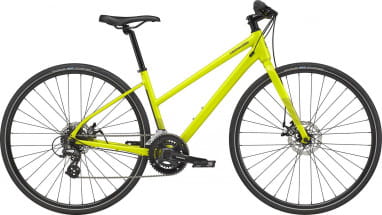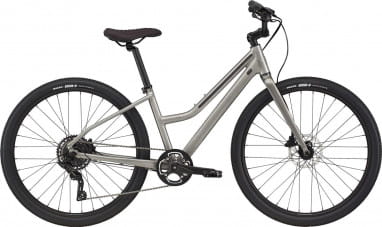Lightweight, fast, economically equipped. That doesn't sound bad, does it? But what exactly is a fitness bike, is probably best explained in comparison to other bikes. And what is a cross bike then? And why have both been somewhat forgotten by the triumph of gravel bikes - and quite unjustifiably so? Let's take a closer look at these fancy racers! Incidentally, the cross bike is often mistakenly lumped together with the Cyclocoss bike, more about this you will find a little further down.
The shortcut:
This is a fitness bike - Interesting facts about fitness bike or cross bike
.
A fitness bike you can also often find under the name cross bike, but the two types of bikes are usually not quite identical. For better orientation, we describe the fitness bike first in comparison to other bikes. After that, we will take a closer look at the most important features of the practical all-rounder.
What is the difference between fitness bikes and other types of bicycles?
In other divisions, this section can be found further down in the buying guide. But since fitness bikes are sometimes really difficult to distinguish from other types of bikes, we'll start with this question for a change.
Fitness bike vs. mountain bike vs. road bike
.
A fitness bike is pretty close to a mountain bike hardtail and a classic racer, more or less it's a mix of both. Actually, a fitness bike is a road bike made all-terrain. For the layman, however, this lineage is hard to discern, because it gets a straight handlebar (or a flatbar) instead of the telltale race handlebar. Here are the bike types in direct comparison:
|
Fitness bike
|
Mountain bike hardtail
|
Race bike
|
|
Upright, back-friendly sitting posture
|
Sporty sitting posture
|
Deep, elongated sitting posture
|
|
Tires suitable for moderate terrain
|
Wide, grippy off-road tires
|
super narrow, fast tires
|
|
light
|
relatively heavy
|
ultra-light
|
|
Focus on off-road speed
|
Focus on off-road
|
Focus on speed
|
|
no suspension
|
Good suspension, suspension fork
|
especially stiff and efficient
|
|
Depending on the model, trekking gears, smaller MTB gears or gravel-specific gears
|
Mountain bike shift groups with a wide range, today often 1x shifters
|
typical road bike shift groups
|
|
Flatbar
|
Flatbar (usually very wide)
|
Dropbar
|
|
Suitable for fast, endurance training rides as well as for pleasurable laps, a day-to-day kit needs to be upgraded, a touring kit as well, rides on asphalt and off-road
|
Suitable for off-road adventures
|
Suitable for top speed on smooth surfaces
|
Is a fitness bike always a cross bike?
A hair-trigger definition that distinguishes for all time between fitness bikes and cross bikes does not exist. Often, the characteristics of the two types of bikes more or less overlap. In general, a fitness bike or cross bike is a perfect training tool and at the same time a cheap everyday bike. It is quite usable in moderate terrain, and it also scores with low weight. In either orientation, you get a performance-oriented bike, so a real sports machine, not a cozy cruiser.
Often the exact interpretation of the bikes simply depends on the manufacturer or the two terms crossbike and fitness bike are equated. With each new model year, the characteristics like to shift in one direction or another. Therefore, the following list is also not set in stone and the properties do not apply to all manufacturers, models and vintages.
The fitness bike
- Tight to the road bike, therefore quite road-oriented
- brings a road bike shifting group or trekking group
- the geometry is oriented to the road bike, but is clearly "defused"
- narrow, fast tires
- more filigree
- little tire tread
- Little equipment, light and cheap
The cross bike
- A good mix of off-road and road capability
- possibly equipped with a smaller MTB shift group
- broader tires
- coarser tire tread
- slightly heavier and more robust
- stable enough for riding on uneven surfaces
- little equipment
Fitness bike - fixie/ singlespeed
Also with our fixies and singlespeed bikes you can read that here you buy a bike with very reduced equipment. However, these bikes are reduced to the bare essentials for city riding. A fitness bike brings the minimum equipment for terrain rides, there is a difference! In the city and on paved roads you can manage without a gear shift and without a potent braking system. Off-road, both are absolutely essential, which is why a fitness bike has these components on board.
Why can't you just buy a city bike, gravel bike or a trekking bike?
On a city bike or a trekking bike, you'll probably sit even a touch more upright than on a fitness bike. The main difference between these bikes and a fitness bike is the features. On bikes for the city and Biketrekking is usually installed everything that the bicycle attachments market gives: Lights, mudguards and luggage racks are present. They are therefore significantly heavier and also more cumbersome. On the fitness bike you will find only the screw-on eyelets and can decide piece by piece for yourself what may come along.
Actually, fitness bikes were the predecessor of the currently absolutely hip gravel bikes. Both use road bike frames, but gave them a much more diverse range of use with wider tires and a corresponding gear shift. The most significant difference remains the drop bar. A gravel bike often has the entire touring equipment in addition to the road bike handlebars also mostly ex works.
> Here you can compare fitness bikes with city bikes, trekking bikes and gravel bikes.
A cross bike should not be confused with a cyclocrosser!
A cyclocross bike is an off-road equipped road bike, it is optimized forcyclocross racing. It has an aggressive geometry and delivers pure propulsion, so it is best suited for high speeds in short races on unpaved surfaces. For everything else, so everyday driving, touring or endurance training it is rather not intended.
> For comparison, go here to our cyclocrossers.
Also, please don't confuse: Fitness Bike ≠ Fitness Bike!
It depends where you're riding, but many bike sites or online bike stores don't refer to the fast, minimally equipped bikes as fitness bikes we're talking about here! Frequently bike indoor trainers are also called fitness bikes! Especially if it is a ergometer, which does not turn your bike into a workout machine for indoors, but which has its own saddle and handles, a classic bike trainer just, is here also like to talk about a fitness bike.
The equipment of a fitness bike
.
- Shift groups for fitness bikes
To ensure that cross bikes can also cope well on forest tracks or dirt roads, there are off-road gear groups from the MTB sector on some models.If you're buying a fast fitness bike that is strongly oriented towards road bikes, however, a race bike group is more likely to be fitted. The range of available gears is so in this division particularly large. There are no hub gears, for the orientation of the bikes clearly too sporty, but you have the choice between models with wide-ranging 3-speed gears, which come from the trekking area, speed-oriented road bike groups (occasionally with compact cranks) and MTB groups, which are characterized primarily by a wide gear range.
Which of these is the right gear, you can easily find out if you think about what you intend to do with your bike.For training laps, touring riders and commuters, a trekking gear is best suited. If you're more likely to take on unpaved terrain and climbs/descents under your wheels, you should look for a bike with an MTB group. If you're going for brisk rides on tar, a fitness bike that's close to a road bike is the best choice.
As off-road sport bikes, fitness bikes usually have disc brakes. The high braking efficiency doesn't hurt in any case, whether you're going off-road or going extra fast on a race-oriented fitness bike. On cheaper bikes, mechanical disc brakes are installed, more expensive models usually have hydraulic discs. Here, the braking power is even better, which means you can achieve more deceleration with less hand force.
Many manufacturers use frames from other areas for their fitness bikes. A trekking bike becomes a fitness bike with slimmed-down equipment and faster tires. A road bike becomes more comfortable, more versatile and also a fitness bike with wider tires, flat bar and less reach. Even a hardtail mountain bike can pass for a cross bike with narrow tires. Your bike will be especially light and easy to handle if you treat yourself to a frame made of carbon. Then the bike is very light, it rides and accelerates easier, and is child's play to lift.
Since fitness bikes have a sporty character, they are usually built on a diamond frame, versions for men or special women's bikes do not exist.
Many fitness bikes roll on 28-inch tires. The tire width ranges from 35mm to 42mm, so the bike has enough cushioning and grip for loose surfaces, gravel or forest trails. There's enough tread on the tires to get you off the paved roads.
Since fitness bikes tend to be built for high speeds, the geo and tires tend to work towards acceleration, good traction and smoothness. The fact that the maneuverability falls by the wayside is accepted.
For cross bikes and fitness bikes alike, you buy a lightweight, versatile bike. It can be used both in the city and in everyday life, for training purposes or off-road. The driving posture is sporty but not too low, the reduced equipment makes the bikes not only light, but also cheap.
Is a fitness bike the right bike for you?
You are looking for a versatile, sporty bike? You want to decide spontaneously which surfaces, routes or areas you take under the wheels? You don't want to worry about maintenance and service? You have to carry your bike down to the basement or up to the office? You don't want the purchase to make you poor? You want to bolt on a full touring kit when needed?
Street or dirt road, heat in summer or icy roads in winter, commute or training lap, top speed or family outing - your bike should be able to do as much as possible?
Then a versatile, lightweight and fast fitness bike is just the bike for you!
The features of a fitness bike:
- cheap to buy
- Little maintenance required
- versatile in use
- City and offroad
- is suitable for changing surfaces
- can be additionally equipped as desired
- lightweight
- Sporty but comfortable riding position
- performance-oriented bike
How does a fitness bike ride?
You've already read it above, fitness bikes can't be pinpointed exactly. Mache of the bikes are very speed-oriented in their geo and equipment, others are then but rather off-road and thus something (but only something!) ponderous. Here it depends on the basis, so the frame.
The frame decides the sitting posture, although of course you can always readjust the Reach with a cranked seatpost and a longer or shorter stem.
The frame material also affects the feel and handling of the bike. Fitness bikes come with frames made of steel, aluminum or carbon. A steel frame is a little heavier, but the material has a good self-damping, it gives a little. A steel frame is also a purchase for life, but should it break, it can be welded. This is not possible with aluminum and carbon, but these two materials are lighter and the frames are low-torsion and stiff and thus particularly force-saving to drive.
Because fitness bikes do not have suspension, they deliver a very direct, unadulterated, sporty ride. The steering is also direct and responsive.
The tires have a great influence on the driving experience. Generally, there's a bit more tire clearance on the fitness bike and the cross bike, so you can mount tires of different widths for less rolling resistance or more bounce and grip.
If you buy a model with a 1x-MTB-gear, your bike weighs the same even slightly less, the bandwidth of the circuit will still be sufficient for many different surfaces. A road bike circuit will convert your muscle power into speed without losses. A bike with trekking gears is a persistent mile eater.
The features of a fitness bike:
- Good off-road or fast, depending on your orientation
- light and easy to handle
- builds up speed
- sporty to drive
- enough tire clearance for a choice of tire width to suit your taste
- unadulterated, crisp driving feel
- direct steering
- the transmission bandwidth depends on the installed circuit
What are the advantages of a fitness bike or cross bike?
A fitness bike convinces with its uncomplicated versatility.Thanks to its lightweight, universal frame and robust components, it is designed for all riders who want to buy a sporty bike, but are looking for variety. Road bike or MTB? You don't have to commit here, a fitness bike can do both.
Few, uncomplicated components usually also mean that the bikes have a cheap purchase price, require little maintenance and are not particularly prone to damage.
The direct relationship to the road bike makes cross bikes and fitness bikes fast and very efficient. If you want a little more suspension, look for plenty of tire clearance or retrofit a suspension fork.
A cross bike has on the frame (probably) the mounting points for luggage rack, water supply, mudguards and co. If you need them, you can attach them. If you no longer need them, you can of course unscrew them again, so your bike loses a few kilos in one fell swoop and drives much sportier and lighter.
The advantages of a fitness bike:
- lightweight
- Versatile all-rounder
- affordable
- athletic
- efficient
- low maintenance
How much does a fitness bike cost?
The math is simple: few components mean less cost. Fitness bikes take their cues from road bikes, but fortunately without calling up the top prices that road bikes tend to command. You won't find the crazy expensive top components here, so the bikes are reasonably priced. Of course, there are high-end fitness bikes that seamlessly combine the performance of a road bike with the versatility of a gravel bike. But even with an inexpensive bike you can do successful training laps. With which acquisition costs you must count?
Fitness bikes are already very cheap to have, many entry-level models are well below 1000 euros. They are best suited for Gegenheitsbiker, who want to enjoy a brisk, sporty driving experience on infrequent trips. The simple design, which does not require much adjustment and maintenance, is another advantage here.
If you want to get on your bike regularly, rely on it daily or really want to train, you should spend a little more.In the mid-range between 1000 euros and 2000 euros you get a really good bike. You buy a reliable shifting group with, probably also hydraulic disc brakes and a robust aluminum frame.
Since some manufacturers also sort carbon sleds with first-cream complete groups to their fitness bikes, you can occasionally push the price regulator to over 10 000 euros. The bikes you then find at the upper end of the scale tend to be professional racing bikes with off-road equipment. They are, of course, lightweight and off-road capable, and thus adhere to two of the basic requirements. "Cheap" you'll just have to cross out then. Normally, the scale for fitness bikes and cross bikes ends at about 3000 euros. Here there are carbon frames, excellent groups from the MTB sector or good road bike groups. Hydraulic disc brakes should of course be installed, you can also expect good tires from the factory.
The price ranges at a glance:
What do you have to look for when buying?
- Where do you want to ride? What are the surfaces like?
You've already read it above, fitness bikes are rather close to road bikes, cross bikes are mostly oriented to mountain bikes. So if you like to make urban bike paths and country roads unsafe, a road bike derivative is the right bike for you. If you're drawn to the outskirts of the city, a relative of the mountain bike is a good choice. Wide tires also make your bike rideable on many surfaces.
- How often do you get on your bike? How long do you ride?
The longer your training rounds, the more reliably and smoothly rides a good bike that cost a little more. If you use your bike infrequently and for short distances, a cheap bike may be enough. Quality goes up with price, so experience has shown that a bike that costs a little more will be more fun and less hassle.
- Do you like to ride comfortably and upright?
If you like to sit upright and have good all-around vision, you shouldn't necessarily buy a fitness bike that leans too much toward a road bike. Road cyclists stick with the nose almost on the stem, not every cyclist and not every back makes this without complaint! A cross bike with a moderate geometry will still provide enough propulsion, but it rides much more pleasantly.
For your riding comfort is also a good damping very advantageous. It can consist of different elements. Tires with a large circumference dampen bad surfaces and provide a good grip. A steel frame provides some flexibility. There are suspension saddles and saddle posts. A suspension fork is very rare on a fitness bike, but ... your bike - your rules!
Without suspension, your fitness bike will ride crisp, direct and fast.
- Is the reduced equipment enough for you?
Mudguards, lights and so on are rather rare to find on sporty performance bikes, this also applies to fitness bikes and cross bikes. However, you can reach for the screwdriver yourself and retrofit.
- Which is the appropriate frame size?
You want to torture yourself on the bike with a sweaty fitness program? We won't advise against it! However, the bike should not torture you with a lousy fit, because then your rides will be very uncomfortable. When it comes to wheel size, there's little choice; most fitness bikes ride on 28-inch tires. However, the frames are available in S, M, L or XL. Our blog article "How to determine the right tire size" will help you choose the right bike size.
Buy a fitness bike from best manufacturer
.
Here in the online store you can find fitness bikes and cross bikes from different manufacturers. We work exclusively with reputable manufacturers, so we can offer you bikes in good quality, where no-name products simply could not keep up. Here you can find bikes from Breezer, OctaneOne, All-City and Giant.
If you're still not sure which bike to order, you can easily compare different bike categories here on Bike Mailorder. Our buying guides are all structured the same way, so you can quickly find answers to all your bike questions. You can read whether a mountain bike, a road bike or a city bike is the perfect bike for your cycling plans. Ober maybe you'd rather ride an E mountain bike, an E city bike or an E road bike? You can also buy these bikes online right here. Even if you're still looking for bike clothing, spare parts or the right accessories, we can help you out. Have fun browsing!
